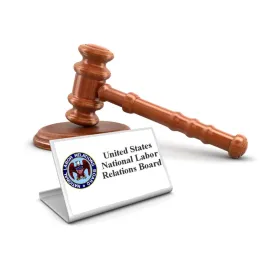-
The National Labor Relations Board (NLRB) found an employer did not violate the National Labor Relations Act (NLRA) by misclassifying its employees as independent contractors. Velox Express, Inc., 368 NLRB No. 61 (Aug. 29, 2019). Velox engaged drivers classified as independent contractors to transport medical samples to hospitals and other medical facilities. After Velox terminated a driver’s contract, she filed an unfair labor practice (ULP) charge alleging the termination was an unlawful response to her complaint to management on misclassification of the drivers. During the ULP proceedings, the NLRB’s General Counsel alleged the drivers were employees, not contractors, and therefore were covered by the NLRA. He argued that Velox violated the NLRA by: 1) discharging the driver for engaging in protected concerted activity; and 2) by misclassifying the drivers as independent contractors. The Board found that misclassifying employees as independent contractors does not, by itself, “inherently coerce” employees in violation of the NLRA, and therefore is not a standalone violation of the Act. (It also found the driver was an employee covered by the NLRA.) For a full discussion of this decision, see our article, Labor Board: Misclassifying Worker as Independent Contractor Does Not Violate NLRA.
-
The Board set a new standard for evaluating employer rules limiting off-duty contractor employees’ access to an employer’s property. Bexar County Performing Arts Center Foundation, 368 NLRB No. 46 (Aug. 23, 2019). A group of off-duty, unionized orchestra members distributed handbills outside a performing arts center, protesting a resident ballet company’s decision to use recorded music instead of live. The musicians were employees of a symphony that also performed at the center, as a contractor. The center asked police to remove the musicians. The musicians’ union filed an unfair labor practice charge alleging the center violated the NLRA by ejecting the musicians. Overruling NLRB precedent, the Board held a property owner may exclude off-duty contractor employees engaged in Section 7 activity on its property, unless: (1) the contractor employees work “regularly” and “exclusively” on the property; and (2) the owner fails to show the contractor employees have at least one reasonable non-trespassory alternative means to communicate their message. In so holding, the Board overruled its previous standard in New York New York Hotel & Casino, 356 NLRB 907, 916 (2011), enf’d, 676 F.3d 193 (D.C. Cir. 2012), cert. denied, 133 S. Ct. 1580 (2013), which stated that contractor employees can access an owner’s property to engage in protected concerted activity, unless the owner can show the activity would “significantly interfere” with use of its property or its ability to maintain production or discipline. Applying its new test, the Board found the center could lawfully eject the symphony musicians, because they worked at the center only 22 weeks per year, and because they could have demonstrated on a sidewalk across the street, or on social media. For a full discussion of this decision, see our article, NLRB: Property Owners May Limit Off-Duty Access by Contractors’ Employees.
-
The Board ruled the NLRA does not prohibit employers from promulgating mandatory arbitration agreements in response to employees opting-in to a collective action. Cordua Restaurants, 368 NLRB No. 43 (Aug. 14, 2019). The employer maintained an arbitration agreement requiring employees to waive their right to file, participate, or proceed in class or collective actions in any court or arbitration proceeding. After employees filed a collective action alleging violations of various wage statutes and a number of employees opted into the collective action, the employer issued a revised arbitration agreement under which employees had to agree not to opt into collective actions. Employees filed an unfair labor practice charge alleging the employer violated the NLRA by requiring them to sign the revised agreement under threat of possible discharge. In light of the U.S. Supreme Court’s decision in Epic Systems Corp. v. Lewis, which held that employers do not violate the NLRA when requiring that employment-related claims be resolved through individual arbitration, the Board found the employer did not violate the Act by issuing the revised arbitration agreement. According to the Board, opting into a collective action is merely a procedural step for participating as a plaintiff in a collective action, not a substantive Section 7 right in itself. It follows, the Board found, that an arbitration agreement that prohibits employees from opting into a collective action does not restrict any rights under the NLRA. For a full discussion of this decision, see our article, Supreme Court’s Epic Systems Decision on Arbitration Interpreted Broadly by Labor Board.
-
The NLRB held that an employer did not violate the NLRA by stopping benefit increases after expiration of the collective bargaining agreement (CBA). PG Publishing Co., Inc. d/b/a Pittsburgh Post-Gazette, 368 NLRB No. 41 (Aug. 22, 2019). In 2014, the employer signed CBAs with each of the unions representing its employees. The CBAs set the employer’s contribution rates to a union welfare fund, the same fund in each CBA, and provided for maximum increases of 5% in 2015, 2016, and 2017. As the contracts approached expiration, the employer reached an agreement to extend two CBAs, while the remaining five expired in 2017. Thereafter, the fund requested another 5% increase from the employer under the expired and extended CBAs, despite the fact that neither the expired nor the extended agreements provided for increases beyond 2017. The employer declined to pay the increases, stating its sole obligation was to maintain contributions at the 2017 level. The Board found the employer did not violate its statutory duty to continue the status quo under the CBAs, because the status quo required maintaining the contributions at the 2017 level, absent some contractual language providing for increases beyond then.
-
U.S. public sentiment toward unions is at the highest level in years. According to a Gallup survey released on August 28, about 64% of Americans approve of labor unions, an increase of two percentage points from last year’s survey, and an increase of 16 percentage points from an all-time low in 2009. The last time unions enjoyed such high levels of support was in 2002, when 65% of those polled viewed unions in a positive light. Union support remains high among Democrats, with 82% approval. Of Republicans, 45% now approve of unions, up from 29% in 2009. Meanwhile, a Bloomberg analysis of wage data found that union wages are up so far in 2019. The average first-year wage increase in a union contract rose to 3.4%, from 3.1% at the end of 2018. However, when accounting for bonuses, first year wage increases fell in 2019, from 3.9% at the start of the year, down to 3.1% in August.
Top Five Labor Law Developments for August 2019
Friday, September 13, 2019
Current Public Notices
Published: 8 August, 2025
Published: 8 August, 2025
Published: 30 July, 2025
Published: 29 July, 2025
Published: 28 July, 2025
Published: 23 July, 2025
Published: 21 July, 2025
Published: 18 July, 2025
Published: 10 July, 2025
Published: 26 June, 2025









 />i
/>i

